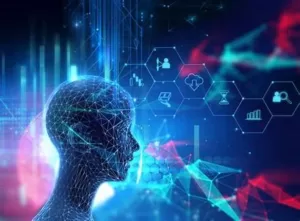The Impact of AI on Precision Agriculture: How Automation is Revolutionizing Farming
The use of artificial intelligence (AI) in precision agriculture is revolutionizing the way farmers manage their crops and livestock. By leveraging the power of automation, AI is helping farmers to increase yields, reduce costs, and improve the sustainability of their operations.
AI-driven precision agriculture is a form of digital agriculture that uses advanced technologies such as sensors, robotics, and machine learning to collect and analyze data about crops and livestock. This data is then used to optimize farming practices, such as irrigation, fertilization, and pest control. By automating these processes, AI can help farmers to reduce labor costs, increase yields, and improve the sustainability of their operations.
One of the most important benefits of AI-driven precision agriculture is its ability to reduce the amount of water and fertilizer used in farming. By using sensors to monitor soil moisture and nutrient levels, AI can help farmers to optimize irrigation and fertilization practices, resulting in less water and fertilizer being used. This can help to reduce costs and improve the sustainability of farming operations.
AI can also help farmers to detect and diagnose crop diseases and pests more quickly and accurately. By using sensors and machine learning algorithms, AI can detect and identify pests and diseases before they become a major problem. This can help farmers to take action quickly, reducing the amount of damage caused by pests and diseases.

Finally, AI can help farmers to optimize their crop yields. By using machine learning algorithms to analyze data about soil conditions, weather patterns, and crop growth, AI can help farmers to identify the best practices for maximizing yields. This can help farmers to increase their profits and reduce their environmental impact.
In conclusion, AI-driven precision agriculture is revolutionizing the way farmers manage their crops and livestock. By leveraging the power of automation, AI is helping farmers to reduce costs, increase yields, and improve the sustainability of their operations. As AI technology continues to advance, it is likely that its impact on precision agriculture will only become more profound.
Exploring the Potential of AI-Driven Food Production: What the Future Holds
The potential of artificial intelligence (AI) to revolutionize food production is immense. AI-driven food production has the potential to revolutionize the way food is grown, harvested, and processed, leading to more efficient and sustainable food production. In this article, we will explore the potential of AI-driven food production and what the future holds.
AI-driven food production has the potential to revolutionize the way food is grown, harvested, and processed. AI-driven systems can be used to monitor and optimize crop growth, detect pests and diseases, and automate harvesting and processing. AI-driven systems can also be used to optimize the use of resources such as water, fertilizer, and energy, leading to more efficient and sustainable food production.
AI-driven systems can also be used to improve food safety and quality. AI-driven systems can be used to detect food-borne pathogens, detect food spoilage, and monitor food quality. AI-driven systems can also be used to detect and prevent food fraud, ensuring that consumers are getting the food they expect.
AI-driven systems can also be used to improve the efficiency of food production. AI-driven systems can be used to optimize production processes, reduce waste, and improve the efficiency of supply chains. AI-driven systems can also be used to optimize the use of resources such as water, fertilizer, and energy, leading to more efficient and sustainable food production.
Finally, AI-driven systems can be used to improve the sustainability of food production. AI-driven systems can be used to monitor and optimize crop growth, detect pests and diseases, and automate harvesting and processing. AI-driven systems can also be used to optimize the use of resources such as water, fertilizer, and energy, leading to more efficient and sustainable food production.
The potential of AI-driven food production is immense, and the future looks bright. AI-driven systems have the potential to revolutionize the way food is grown, harvested, and processed, leading to more efficient and sustainable food production. AI-driven systems can also be used to improve food safety and quality, improve the efficiency of food production, and improve the sustainability of food production. As AI-driven systems become more advanced, the potential of AI-driven food production will only continue to grow.

The Role of Robotics in Automating Food Production: How AI is Changing the Way We Grow Food
The use of robotics and artificial intelligence (AI) in food production is revolutionizing the way we grow food. By automating certain processes, robots and AI can help increase efficiency, reduce costs, and improve the quality of food production.
Robots are being used in a variety of ways to automate food production. For example, robots can be used to plant, water, and harvest crops. They can also be used to monitor soil conditions, detect pests, and apply fertilizers and pesticides. In addition, robots can be used to sort and package produce, as well as to inspect and grade food products.
AI is also being used to automate food production. AI-powered systems can be used to analyze data from sensors and cameras to detect problems in the production process. AI can also be used to optimize the use of resources, such as water and fertilizer, and to predict crop yields.
The use of robotics and AI in food production has many benefits. Automation can reduce labor costs and increase efficiency, allowing for larger yields with fewer resources. It can also reduce the risk of human error, resulting in higher quality food products. In addition, automation can help reduce the environmental impact of food production by reducing the use of pesticides and other chemicals.
Robotics and AI are transforming the way we grow food. By automating certain processes, robots and AI can help increase efficiency, reduce costs, and improve the quality of food production. As technology continues to advance, the use of robotics and AI in food production will become even more widespread, leading to even greater benefits for farmers and consumers alike.
The Benefits of AI-Powered Food Production: How Automation is Reducing Waste and Increasing Efficiency
The use of artificial intelligence (AI) in food production is revolutionizing the industry, providing a range of benefits that are reducing waste and increasing efficiency. AI-powered automation is helping to streamline processes, reduce costs, and improve the quality of food products.
One of the most significant benefits of AI-powered food production is the reduction of food waste. AI-driven automation can help to identify and address potential problems before they become costly issues. For example, AI-driven sensors can detect when food is spoiled or contaminated, allowing producers to take corrective action before the product is shipped. This helps to reduce the amount of food that is wasted due to spoilage or contamination.
AI-powered automation is also helping to reduce costs associated with food production. Automation can help to streamline processes, reducing the amount of time and labor required to produce a product. This can help to reduce overhead costs, allowing producers to pass the savings on to consumers. Additionally, AI-driven automation can help to reduce the amount of energy and resources required to produce a product, further reducing costs.

Finally, AI-powered automation is helping to improve the quality of food products. Automation can help to ensure that products are produced consistently and to a high standard. AI-driven sensors can detect when a product is not up to standard, allowing producers to take corrective action before the product is shipped. This helps to ensure that consumers receive a high-quality product every time.
In conclusion, AI-powered automation is revolutionizing the food production industry, providing a range of benefits that are reducing waste and increasing efficiency. AI-driven automation is helping to reduce food waste, reduce costs, and improve the quality of food products. As AI technology continues to advance, these benefits are only likely to increase.
The Challenges of AI-Driven Food Production: What We Need to Consider Before Adopting Automation
The advent of artificial intelligence (AI) has revolutionized the food production industry, offering the potential to increase efficiency, reduce costs, and improve the quality of food products. However, the adoption of AI-driven food production comes with a number of challenges that must be considered before implementation.
First, AI-driven food production requires significant upfront investments in technology and infrastructure. This can be a major barrier for smaller producers who may not have the resources to make such investments. Additionally, AI-driven food production requires a high level of technical expertise to operate and maintain the systems. This can be a challenge for producers who lack the necessary skills and resources to train their staff.
Second, AI-driven food production can lead to a loss of jobs. Automation can reduce the need for manual labor, resulting in fewer jobs for workers. This can have a significant impact on local economies, particularly in rural areas where food production is a major source of employment.
Third, AI-driven food production can lead to a decrease in food safety and quality. Automated systems can be vulnerable to errors and malfunctions, which can lead to food contamination or spoilage. Additionally, AI-driven systems may not be able to detect subtle changes in food quality, such as changes in flavor or texture.
Finally, AI-driven food production can lead to a decrease in food diversity. Automated systems may be unable to produce certain types of food, such as artisanal or specialty products. This can lead to a decrease in the variety of food available to consumers.
In conclusion, AI-driven food production offers the potential to increase efficiency and reduce costs. However, it is important to consider the potential challenges before adopting automation. Producers should carefully weigh the costs and benefits of AI-driven food production and ensure that they have the necessary resources and expertise to implement and maintain the systems.







